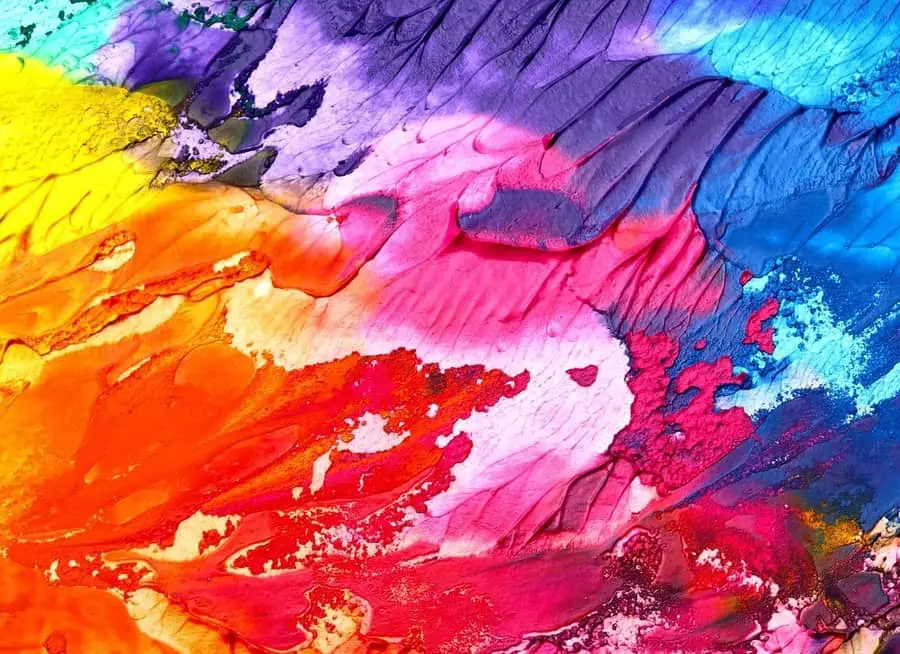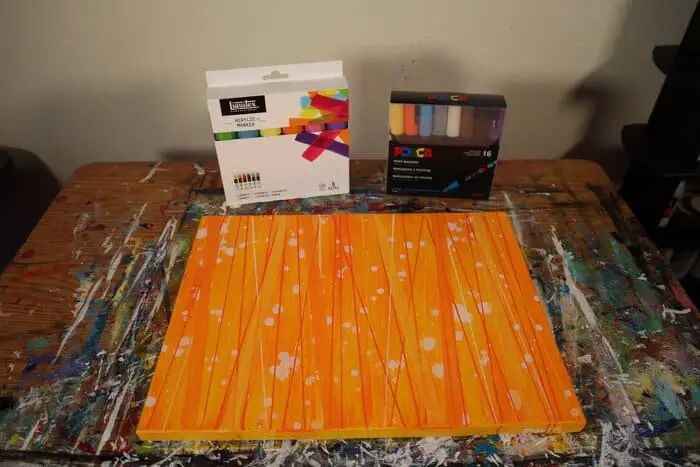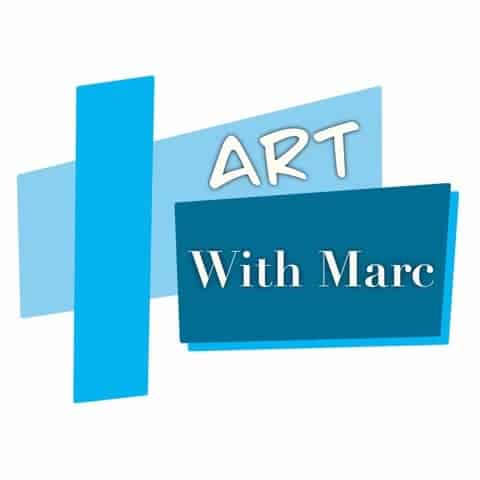
It’s a common misunderstanding that to learn the art of abstract painting all one needs to do is just throw paint on a canvas and call it art. Just like in any other art form, there are many basic skills an aspiring abstract painter can focus on honing in order to improve the quality of their compositions.
The most fundamental skills and abstract artist can hone are sharpening their understanding of the elements of art, the principles of art, color harmonies, the various textures there are to use and the variety of ways tools can be used in abstract art are all skills that good abstract artists work on honing.
Having a deeper understanding of each of these areas will help any abstract artist to develop the skills needed to create cool images to look at. Lets look at each briefly to see how and why they can help.
The Elements of Art

The elements of art are commonly referred to as the most basic building blocks of art. They inform us on the most fundamental tools we have to formulate images on command.
The elements of art are color, value, texture, line, shape, space, and form.
We use the elements of art to compose the visual music that makes up our artwork. Playing with things like space, shape and form are all great ways to enhance your abstract skills.
One thing I like to do that I highly recommend you give a try is to simply focus on one particular element for a whole painting. Do a painting where your main focus is to learn and understand more about space.
What are ways that space can be used and implemented effectively in an abstract way? Collect a Pinterest board filled with examples of different ways the element of space is applied and used then draw inspiration from your collection.
Exercise your ability to recognize and utilize the element of space and it will begin to creep into your work on unconscious levels.
This is true for ALL of the elements of art. Each can be broken down and studied in more depth. Each can be practiced so that it becomes something you just do and use without much thought.
Once you wield the elements of art with proficiency the principles of art will go a long way towards increasing your understanding of ways you can arrange the elements in a visually pleasing way.
The Principles of Art
If the elements of art are the building blocks then the principles of art are tools we can use to decide upon how to arrange those building blocks into something visually pleasing.
The principles of art are proportion, contrast, balance, movement, rhythm, emphasis, and harmony.
When each principle is understood and applied skillfully the overall quality of the final piece is improved.
If your goal is to eventually achieve a level with your paintings that will allow you to make a living off of them it’s important to understand what sorts of visual patterns humans find appealing.
Despite what many like to think and say, there are measurable standards of arrangements and patterns that are proven to illicit responses out of people.
While I agree that it’s true that beauty is subjective to a large degree, I also think that understanding and honing the skills mentioned on this page will go a long way to one developing one’s artistic abilities. The principles of art are an excellent set of mental tools to study that will help you improve.
Once you know them you will begin to see how the principles of art are used in every single piece of artwork you like and admire. You may even find that you were utilizing them yourself before you even knew what they were.
The abstract world and abstract artists in general are often very obscure when it comes to how they do what they do. I intend to be far more direct with you and provide you some clear skill sets you can aim at working on that I’m sure will help you make awesome artwork!
Understanding Color Theory and Color Harmonies
One of the most mentioned skillsets any abstract artist who is worth their salt will mention is understanding colors.
Color is so important that it takes up 2 of the 5 elements of color AND is worthy of having its own field of study known as color theory.
Understanding how certain colors of paints mix together, color harmonies, how to get certain levels of hue and saturations are all separate studies within the field of color itself.
Learning about basic color harmonies and experimenting with using them is a great place to start. Playing with complimentary, analogous, triad, split complimentary, tetradic, and square harmonies will go a long way to gaining a stronger grasp on colors.
I would recommend picking one of these color harmonies, looking at the color wheel, selecting your colors based off of that particular harmony, and then making a painting using ONLY those colors within the harmony.
As you build up your understanding and experience with each harmony you can start challenging yourself to use multiple different harmonies in your works. I like to think of color harmonies as color chords and that when I combine a few together I’m making visual music for your eyes to dance on.
Practicing color harmonies and using them effectively will likely lead to another important understanding of how to mix your colors to get the desired color you want.
This isn’t as straight forward as you would think as certain paints have color biases that impact how they will mix together.
For more on color biases check out my page on how “Blue and Red Don’t Always Make Purple” here.
Beyond understanding color, one of the least mentioned and talked about skills of the abstract world is sharpening ones ability to use different textures and tools.
Understanding Textures and Tools
Texture is one of the 7 elements of art discussed in the very first section of this page. Just as with color texture has multiple layer of depths to explore.
There is visual texture like the kind conveyed from painting a soft pillow or a hard brick. This is called implied texture.
This simulation of texture is the ability to translate those tactile properties of the object that one can deduce visually and have them understand in their minds that a particular object is rough, hard, or soft just by looking at it.
There is of course real texture too. These are the physical textures we add to the canvas. Things like texture pastes and cement that we add to our painting surface for different effects.
The tools we use to apply our paints and pastes can be just as important too. You can get a variety of textures just from applying your paint on thickly and with different types of tools.
Hard rubber rollers are a good example of a tool you can use that simultaneously spreads your paint while also giving it a rather cool texture too.
Rubber catalyst wedges and catalyst knives are great tools to have if you’re looking to carve interesting patterns in your textures.
If you’re looking to just use texture pastes and experiment there are many to choose from. The liquitex lineup is always a good place to start.
They have pastes like blended fibers, black lava, glass beads, ceramic stucco, and natural sand.
They also have a variety of gels you can pick up too from matte up to high gloss. These gels are used to add thickness to the paints and allow for more an impasto style of painting.
These sorts of products are available from all different types of standard artist paint brands. Liquitex, Golden, and Tri-Art all have a variety of selections for us to try and flex our texture skills with.
I hope now you see there are skills abstract artists need to study, understand, and develop in order to take their craft to the next level! If you take the time to hone these skills you will certainly see an improvement in your results!

